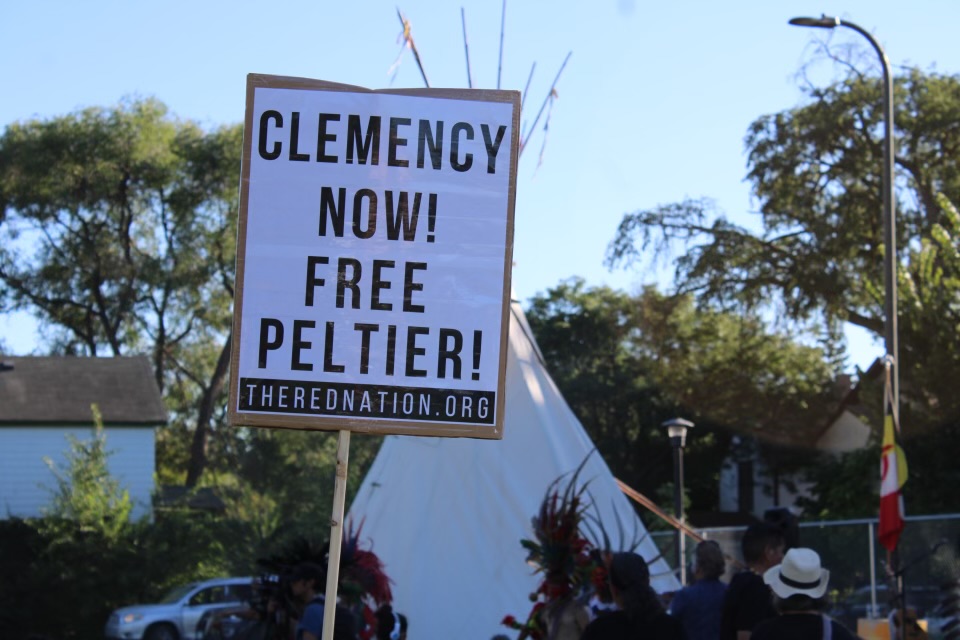
- Details
- By Darren Thompson
MINNEAPOLIS—The American Indian Movement (AIM) Grand Governing Council hosted a rally yesterday in Cedar Field Park to kick off a 15-week national walk demanding the release of Leonard Peltier.
The “Walk to Justice: Free Leonard Peltier” will travel from Minneapolis through Wisconsin, Illinois, Indiana, Ohio, and Pennsylvania, ending in Washington, D.C. on November 14.
“This is not an easy thing to plan a national walk,” Rachel Thunder, lead walk organizer and director of AIM’s True People of Indiana and Kentucky Chapter, said during the rally. “This walk wouldn’t be possible without all of our communities coming together along the way. Our brothers and sisters are going to suffer at this ceremony, just as Leonard has suffered for our people.”
Peltier, a member of the Turtle Mountain Band of Chippewa Indians, was convicted of aiding and abetting in the murder of two Federal Bureau of Investigation (FBI) agents on the Pine Ridge Indian Reservation in June 1975. His co-defendants, Dino Butler and Robert Robideau, were charged with two counts of murder and were acquitted under claims of self-defense.
The charge of aiding and abetting allows a court to convict someone guilty of a crime even if they are not the principal offender.
“Who could he have aided and abetted?” Lisa Bellanger, co-director of AIM’s Grand Convening Council, asked yesterday’s crowd. “We asked the federal government to release our elder and to release him now. And we told them that if it doesn’t happen, we’ll lift the spirit of the people, and we’ll walk to D.C.”
Many organizations have advocated for the release of Peltier and consider him America’s political prisoner. The federal appellate judge who oversaw Peltier’s appeal case, Gerald Heaney, later wrote a letter to former Chair on Senate Select Committee on Indian Affairs Daniel Inouye in 1991 stating that the FBI conducted an improper investigation in securing Peltier’s extradition from Canada.
“Although our Court decided that these actions were not grounds for reversal, they are, in my view, factors that merit consideration in any petition for leniency filed,” Heaney wrote in 1991.
Peltier has been in prison for 46 years.
“The first time I’ve seen my dad was when I was two years old,” Peltier’s daughter, Kathy Peltier, said at yesterday’s rally.
Kathy was born in November 1975, months after the Pine Ridge Indian Reservation shootout in June of that year that led to Peltier’s conviction.
“I’ve been speaking about my dad since I could speak, and we know in our hearts that our dad is free,” Kathy said.
“The day of the shootout in 1975, the FBI created a narrative that some super soldier killed two FBI agents,” Dr. Nick Estes said during the rally. “But they don’t tell you that the vast majority of people at that shootout were under the age of 18.”
Musicians Mitch Walking Elk and Robby Romero closed the evening with performances and stories on their lifetime advocating for the release of Leonard Peltier. In 1992, both musicians performed at the United States Federal Penitentiary in Leavenworth, Kansas.
For more information on the walk, please follow the “Walk to Justice: Free Leonard Peltier” Facebook page. Rallies and events will be hosted along the walk, with a convening in Washington, D.C. on November 14, 2022.
More Stories Like This
Native News Weekly (August 25, 2024): D.C. BriefsUS Presidents in Their Own Words Concerning American Indians
Indigenous Actor Elaine Miles Reports Detention by Alleged ICE Agents
Happy Thanksgiving from Native News Online
Coming Up on Native Bidaské: Behind the Animation: Joey Clift Talks “Pow” and Native Storytelling
Help us tell the stories that could save Native languages and food traditions
At a critical moment for Indian Country, Native News Online is embarking on our most ambitious reporting project yet: "Cultivating Culture," a three-year investigation into two forces shaping Native community survival—food sovereignty and language revitalization.
The devastating impact of COVID-19 accelerated the loss of Native elders and with them, irreplaceable cultural knowledge. Yet across tribal communities, innovative leaders are fighting back, reclaiming traditional food systems and breathing new life into Native languages. These aren't just cultural preservation efforts—they're powerful pathways to community health, healing, and resilience.
Our dedicated reporting team will spend three years documenting these stories through on-the-ground reporting in 18 tribal communities, producing over 200 in-depth stories, 18 podcast episodes, and multimedia content that amplifies Indigenous voices. We'll show policymakers, funders, and allies how cultural restoration directly impacts physical and mental wellness while celebrating successful models of sovereignty and self-determination.
This isn't corporate media parachuting into Indian Country for a quick story. This is sustained, relationship-based journalism by Native reporters who understand these communities. It's "Warrior Journalism"—fearless reporting that serves the 5.5 million readers who depend on us for news that mainstream media often ignores.
We need your help right now. While we've secured partial funding, we're still $450,000 short of our three-year budget. Our immediate goal is $25,000 this month to keep this critical work moving forward—funding reporter salaries, travel to remote communities, photography, and the deep reporting these stories deserve.
Every dollar directly supports Indigenous journalists telling Indigenous stories. Whether it's $5 or $50, your contribution ensures these vital narratives of resilience, innovation, and hope don't disappear into silence.
 The stakes couldn't be higher. Native languages are being lost at an alarming rate. Food insecurity plagues many tribal communities. But solutions are emerging, and these stories need to be told.
The stakes couldn't be higher. Native languages are being lost at an alarming rate. Food insecurity plagues many tribal communities. But solutions are emerging, and these stories need to be told.
Support independent Native journalism. Fund the stories that matter.
Levi Rickert (Potawatomi), Editor & Publisher
